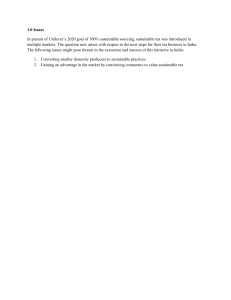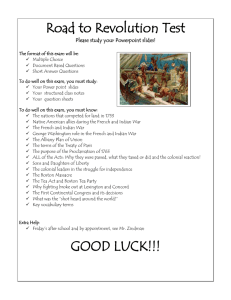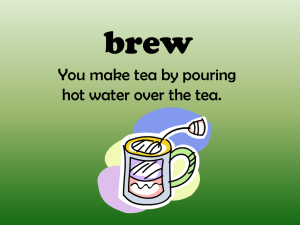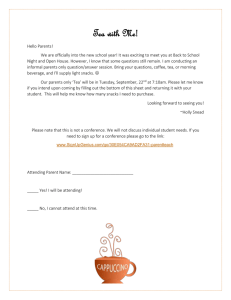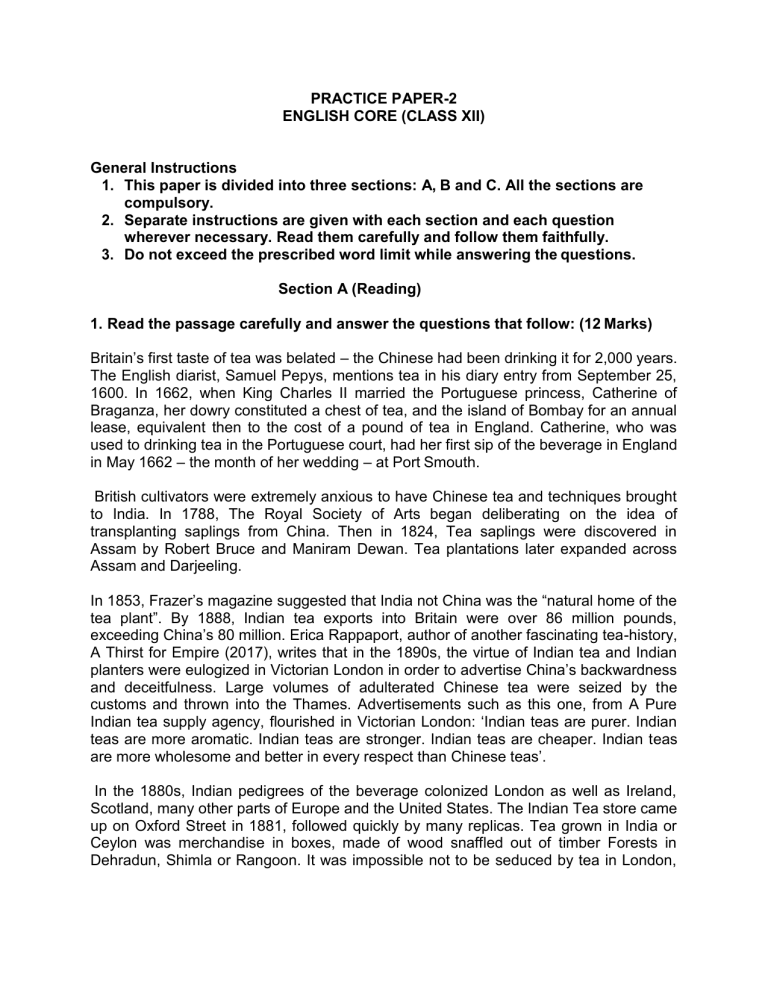
PRACTICE PAPER-2 ENGLISH CORE (CLASS XII) General Instructions 1. This paper is divided into three sections: A, B and C. All the sections are compulsory. 2. Separate instructions are given with each section and each question wherever necessary. Read them carefully and follow them faithfully. 3. Do not exceed the prescribed word limit while answering the questions. Section A (Reading) 1. Read the passage carefully and answer the questions that follow: (12 Marks) Britain’s first taste of tea was belated – the Chinese had been drinking it for 2,000 years. The English diarist, Samuel Pepys, mentions tea in his diary entry from September 25, 1600. In 1662, when King Charles II married the Portuguese princess, Catherine of Braganza, her dowry constituted a chest of tea, and the island of Bombay for an annual lease, equivalent then to the cost of a pound of tea in England. Catherine, who was used to drinking tea in the Portuguese court, had her first sip of the beverage in England in May 1662 – the month of her wedding – at Port Smouth. British cultivators were extremely anxious to have Chinese tea and techniques brought to India. In 1788, The Royal Society of Arts began deliberating on the idea of transplanting saplings from China. Then in 1824, Tea saplings were discovered in Assam by Robert Bruce and Maniram Dewan. Tea plantations later expanded across Assam and Darjeeling. In 1853, Frazer’s magazine suggested that India not China was the “natural home of the tea plant”. By 1888, Indian tea exports into Britain were over 86 million pounds, exceeding China’s 80 million. Erica Rappaport, author of another fascinating tea-history, A Thirst for Empire (2017), writes that in the 1890s, the virtue of Indian tea and Indian planters were eulogized in Victorian London in order to advertise China’s backwardness and deceitfulness. Large volumes of adulterated Chinese tea were seized by the customs and thrown into the Thames. Advertisements such as this one, from A Pure Indian tea supply agency, flourished in Victorian London: ‘Indian teas are purer. Indian teas are more aromatic. Indian teas are stronger. Indian teas are cheaper. Indian teas are more wholesome and better in every respect than Chinese teas’. In the 1880s, Indian pedigrees of the beverage colonized London as well as Ireland, Scotland, many other parts of Europe and the United States. The Indian Tea store came up on Oxford Street in 1881, followed quickly by many replicas. Tea grown in India or Ceylon was merchandise in boxes, made of wood snaffled out of timber Forests in Dehradun, Shimla or Rangoon. It was impossible not to be seduced by tea in London, now a demystified Cleopatra cloned into hundreds and thousands of Darjeeling or Assam boxes. Back in India, the Darjeeling Himalayan Railway, which opened in 1878, was symbiotically rooted to the growth of Indian tea. The first major experiment of the Indian Tea Association – founded in 1881 – for globalizing Indian tea began on the Indian Railways. By 1901, India had grown into a massive market for tea, and in 1903, the Tea Cess bill was passed, regulated cess on tea exports, which would then be used for tea promotion in India and globally. 1.1 On the basis of your understanding of the passage, answer the following questions by selecting the most appropriate of given options: (1x5=5) (a) The fact that Princess Catherine‘s dowry constituted a chest of Tea shows that: (i) She was a Portuguese Princess (ii) She got married to King Charles II of Britain (iii) The cost of a pound of tea was equivalent to the annual lease of an island of Bombay (iv) Tea was not a common beverage in those days (b) It is evident from the diary entry of Samuel Pepe is that: (i) Britain had the first test of tea. (ii) Chinese started drinking tea much before Britain. (iii) Samuel Pepys was a diarist. (iv) Origin of tea in Britain dates back to September 25, 1600. (c) Tea saplings were first found in India in: (i) 1662 (ii) 1788 (iii) 1824 (iv) 1853 (d) Indian Tea was considered better than Chinese tea because: (i) It was published in Frazer’s magazine (ii) India was natural home to tea plant (iii) Indian tea exports into Britain was more than Chinese (iv) India exported 86 million pounds of tea into Britain (e) For tea promotion in India and globally: (i) Tea cess bill was passed (II) Indian Tea Association was founded (iii) Indian Railways was used (iv)Massive market was crated 1.2 Answer the following questions briefly: (1x5=5) a) b) c) d) What was the contribution of British tea cultivators in bringing tea to India? Why was Indian tea preferred over Chinese tea? How was Indian tea advertised to increase its popularity? Why is the relationship between Indian Railways an Indian tea termed as “Symbiotic “? e) It is ironical that Indian Tea colonized many European countries and 1880s. How? 1.3 Find words from the passage that mean the same as the following: (1x2=2) a) Worried (Para 2) b) Contaminated (Para 3) 2. Read the passage carefully and answer the questions that follow: (8 Marks) 1. The internet and social media abound in fake news not just about life, health and politics but also about education and how people learn. Instructional designers, policy makers and most importantly, educators will be well served when equipped with the awareness of how to detect fake news on how learning happens. Much time and money is being invested in capacity building and infrastructure for designing learning, influenced by pseudo science. It is time to Corbet 2. You must have heard of the following phrases: We use only 10% of our brain; individuals learn better when they receive education in their preferred learning styles; A common sign of dyslexia is seeing letters backward; some of us are left brained and some are right brained, and this helps explain differences in learning; Listening to classical music increases children’s learning reasoning ability; children have learning styles that are dominated by particular senses. 3. These are all classic neuromyths. Neuromyths are misconceptions about education, broadly centred around the functioning of our brain and learning. Educators, practitioners and researchers around the world are battling with the neuromyth epidermic. In the last decade or so, neuromyths are being increasingly scrutinised by researchers. 4. They have their roots in the oversimplification of research and of non-expert opinion, which gives rise to misunderstanding. Disinformation has a tendency to blow out of proportion and be exploited by those who have mastered the art of making the untrue appear true 5. Neuromyths must be nipped in the bud, no different from fake news in general. It is high time we stopped getting fooled by gimmicks, by fancy schools or products that claim to help children learn better as they are tuned into the child’s learning style. 6. Get critical while verifying such myths. As a rule of thumb, anything on social media, advertisements and heresay needs to be verified. Begin by searching Google Scholar about a recent assertion you may have heard of. Check the source of the material. Is it from a ‘.com’ site or has it been peer reviewed? Double check the claim by reading counter opinions. Read the ‘about us’ section of the website/source. Check the number of quotes the person has made. Take note of the background and an expertise of the person sharing the information. Pay attention to style, tone and types. Dramatic punctuation and flowery messages should raise questions about credibility. 2.1 On the basis of your understanding of the above passage, make notes on it using headings and sub-headings. Use recognizable abbreviations (wherever necessary – minimum four) and a format you consider suitable. Also supply an appropriate title to it. (4 Marks) 2.2 Write a summary of the passage in about 80 words. (4 Marks) SECTION- B WRITING SKILLS- 30 Marks 3. You are Rajni/Rajan, Headgirl/Headboy of SDS Public School, Meerut. A “Spell Bee” competition is going to be organised in your school. Write a notice to be displayed on the school notice board informing the students about the competition and inviting them to participate. Draft the notice in about 50 words giving all necessary details. Or (4 Marks) You want to sell your bike. Write an advertisement for the “sale and purchase” column of a local newspaper giving all relevant details in about 50 words. 4. Apart from newspapers, 24 hour news channels on TV are a major source of information for the common man. As compared to foreign news channels, the Indian channels are full of advertisements. Write a letter to the editor of a National Daily, urging the news channels to create a healthy balance between news and commercials. You are Sumita/Sumit, 25 A, Ekta Garden Society, Mayur Vihar, Delhi. Or (6 marks) You are Abhinav/Abhinayika Dhar, B 94, Fort Road, Jammu. You have read the advertisement given below. You are qualified for the job write an application in 120–150 words along with the resume. “Indian chemical industries, Delhi require accounts officers, B.Com from a recognised university, at least 4 years of experience, able to maintain books of accounts, preparation of balance sheets, salary – best in the industry. Apply to Managing Director ICI, B-12, Barakhamba Road, New Delhi “ 5. Teenagers are full of energy as well as ideas. Write an article in 150–200 words on “How to channelize the energy of the teenagers”. You are Tejinder Kaur/Tejinder Singh. Or (10 marks) A Tree Plantation drive was organized by your school to encourage residents of nearby colonies to plant more and more trees in the neighbourhood. Write the roport in 150–200 words about the event for your school magazine. You are Mahima/Mahi. 6. “Homes for the aged is a necessity in India“. Write a debate in 150- 200 words either for or against the motion. You are Samridh/Samriddhi Or (10 marks) India has launched its Second Lunar spacecraft Chandrayaan-2. Write a speech to be delivered in the morning assembly on the topic “India’s second mission to moon” You are Saurabh/Surabhi. (150–200 words) SECTION-C ( Text Books) 7. Read the extract given below and answer the questions that follow: (7.1) a) b) c) d) I looked again at her, wane pale As a late winter’s moon and felt that old Familiar ache, my childhood’s fear But all I said was see you soon, Amma, All I did was smile and smile and smile…. (1×4=4) What was poet’s childhood fear? Explain: “late winter’s moon” What is the poetic device used in second line? What does the phrase ‘smile and smile and smile.’ Signify? (7.2) The Yakima River was treacherous. Mother continually warned against it, and kept fresh in my mind the details of each drowning in the river. But the Y.M.C.A. pool was safe. It was only two or three feet deep at the shallow end; and while it was nine feet deep at the other, the drop was gradual. (1×4=4) a) b) c) d) Who was continually warned against Yakima River? How was Y.M.C.A. pool safe? What did mother keep fresh in author’s mind? Find a word from the extract which means ‘dangerous’. 8. Answer any five of the following questions in 30-40 words each: (2×5=10) a) b) c) d) e) f) g) How did Saheb’s life change at the tea stall? What doubts did Edla have about the peddler? What is the ‘sadness’ that the poet refers to in the poem ‘Keeping Quiet’? Why does Charley say, it is easy to get lost at the grand Central station? How does Jo want the story to end? What was Gondwana? What happened to it? How was Bama influenced by the words of her brother, Annan? 9. Answer any one of the following questions in 120-150 words. (6 Marks) Everybody during the last lesson is filled with regret. Comment. OR How different is Jansie from Sophie? 10. Answer any one of the following questions in 120-150 words. (6 Marks) Giving a bribe is an evil practice. How did the Tiger King bribe the British Officer to save his kingdom? How do you view this act of his? OR How did Dr. Sadao help the American Soldier to escape? What humanitarian values do you find in his act?
